Oldsmobile Cutlass Supreme 1995 Owner's Manuals
Manufacturer: OLDSMOBILE, Model Year: 1995, Model line: Cutlass Supreme, Model: Oldsmobile Cutlass Supreme 1995Pages: 340, PDF Size: 16.68 MB
Page 141 of 340
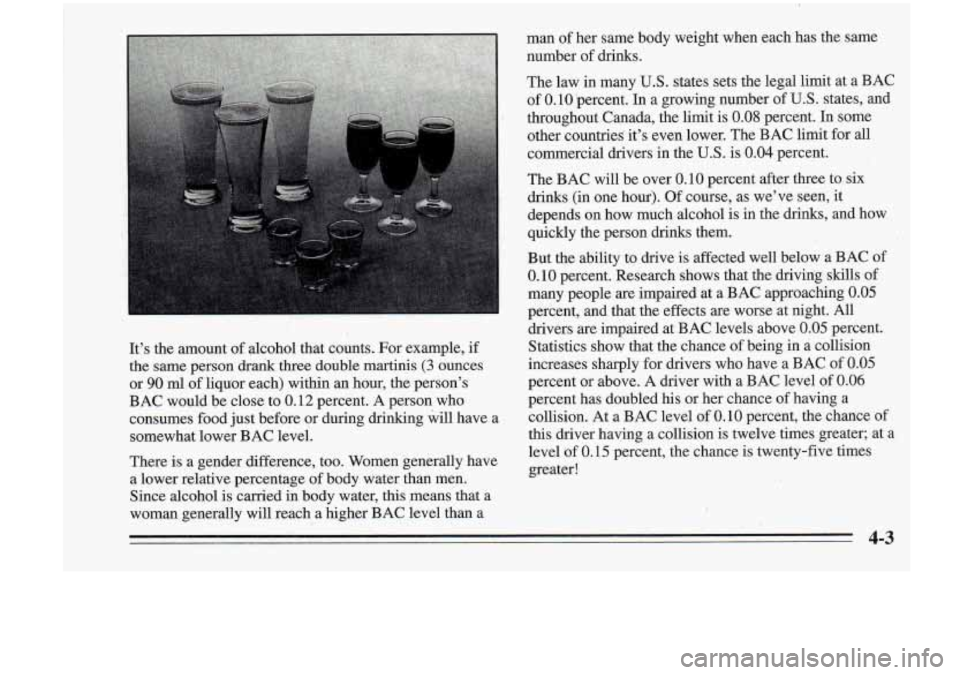
It’s the amount of alcohol that counts. For exmple, if
the same person
&ads three double martinis (3 ounce$
or
90 ml of liquor each) within an hour, the person’s
BAC would be close to 0.12 percent. A person who
consumes fb.od
just before or during drinking will have a
somewhat lower BAC level.
There
is a gender difference, too. Women generally have
a lower relative percentage of body water than men.
Since alcohol is carried in body water,
this means that a
woman generally will reach a higher
BAC level than a
Page 142 of 340
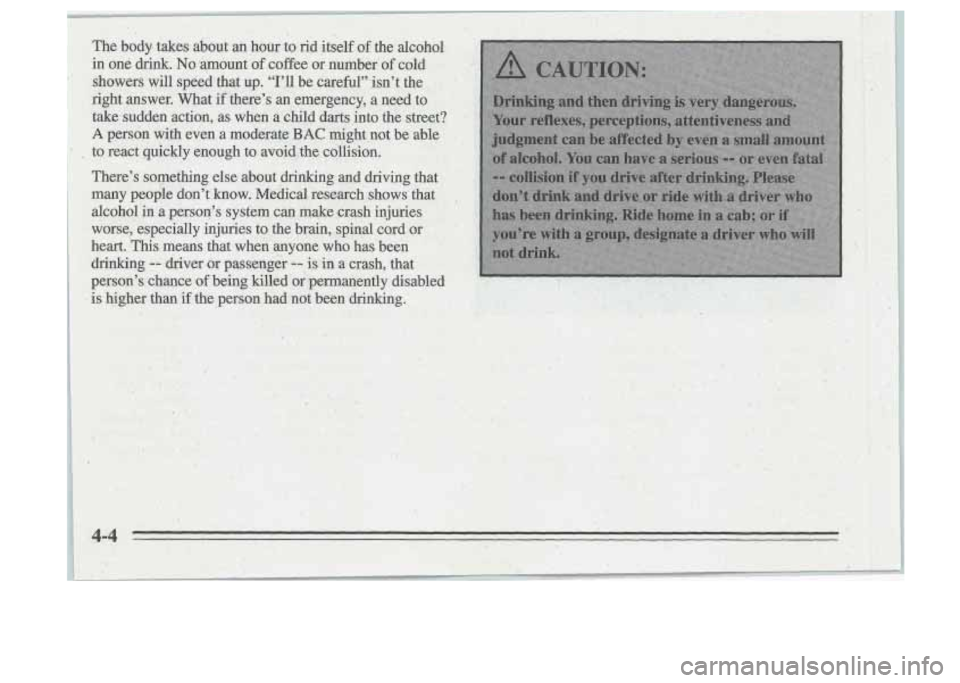
Page 143 of 340
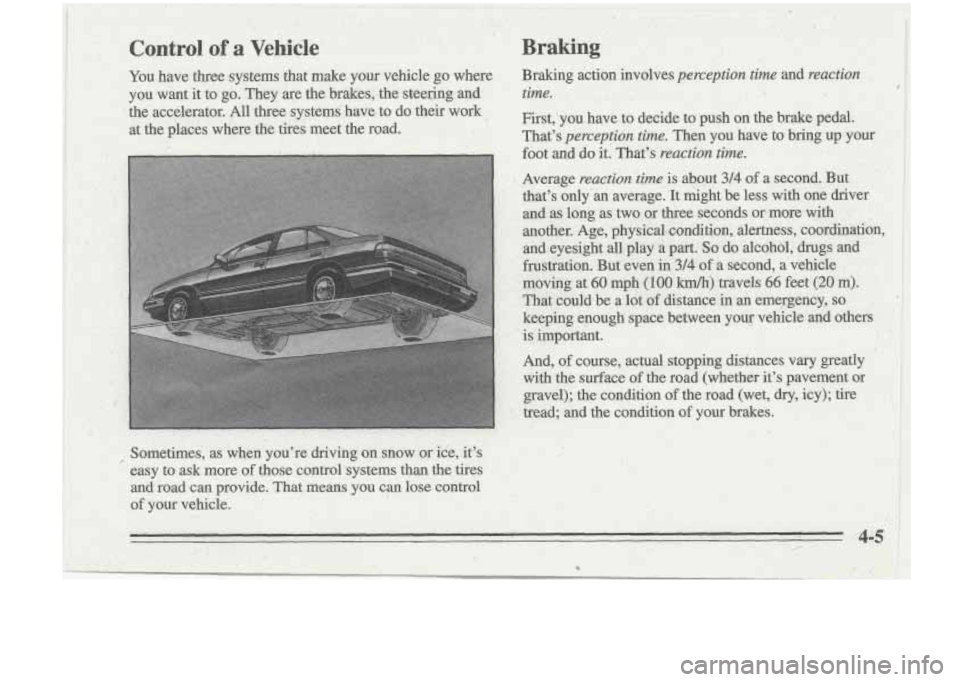
. ..
1 'I
i
Page 144 of 340

I
Anti-Lock Brakes (A S)
Your Oldsmobile has an advanced electronic braking
system that
will help prevent a braking skid.
This light on the instrument
panel will come on briefly
when you start vour vehicle.
RPM X1000
When you start your vehicle, or when you begin to drive
away, you may hear a momentary motor or clicking
noise. And you may even notice that your brake pedal
moves a little while this is going on. This
is the ABS
system testing itself. If there’s a problem with the
anti-lock brake system, the anti-lock brake system
warning light will stay on or flash.
See “Anti-Lock Brake System Warning Light”
in the
Index.
..
Page 145 of 340
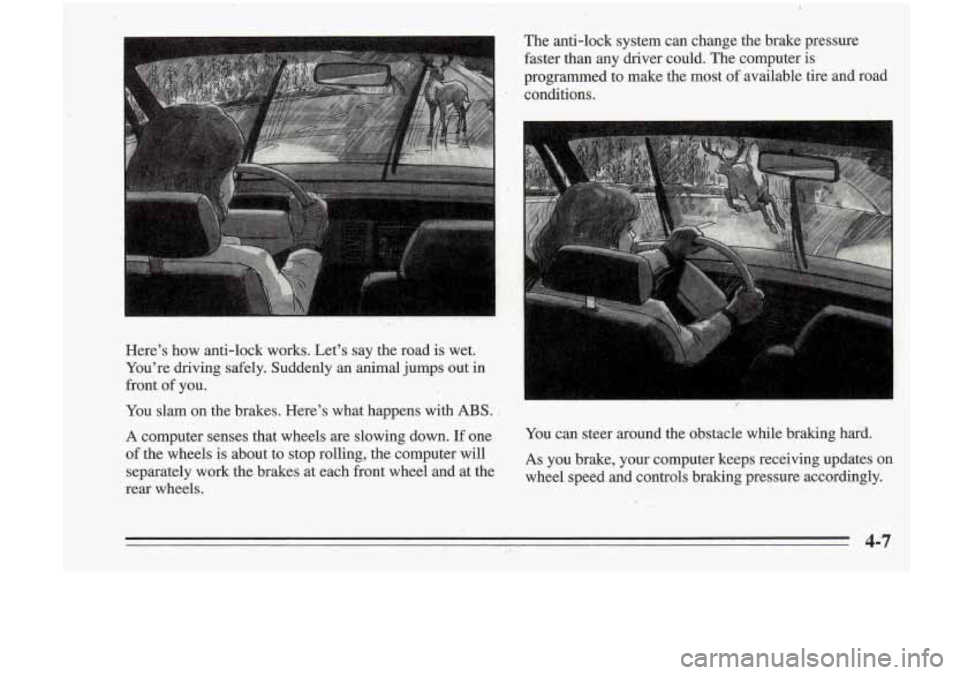
Here's how anti-lock works. Let's say the road is wet.
You're driving safely. Suddenly
an animal juqps out in
front of you. '
You slam on the brakes. Here's what happens with ABS:
A computer senses that wheels are slowing down. If one
of the wheels is about to stop rolling, the computer will
separately work the brakes at each front wheel and at the
rear wheels. The
anti-lock system can change the brake pressure
faster than any
driver could. The computer is
programmed to make the most
of available tire and.road
conditions.
You' can steer around the obstacle while braking hard.
As you brake, your computer keeps receiving updates on
wheel speed and controls braking pressure accordingly.
Page 146 of 340

Remember: Anti-iock doesn’t change the time you need
to get your foot up to the brake pedal.
If you get too
close to the .vehicle in front of you, you won’t have time
to apply your brakes
if that vehicle suddenly. slows or
stops. Always leave enough room up ahead to stop, even
though
you have anti-lock brakes.
,_ Steering
Power Steering
If you lose power steering assist because the engine
stops
or the system is not, functioning, you can steer but
it will take much more effort.
. ..
To Use Anti-Lock
Don’t pump the brakes. Just hold the brake pedal down
and let anti-lock work for you. You may feel the system
working, or you may notice some noise, but this is
normal. When your anti-lock system is adjusting brake
pressure to help avoid a braking skid, the LOW TRAC
light will come’on., See “Anti-Lock Brake System
Active Light”
in the Index.
Braking .,in Emergencies
Usti your anti-lock braking system when you’need to.
With anti-lock, you can steer and brake at the same
time.
In many emergencies, steering can help you more
than even the very best braking.
.‘
Steering Tips
Driving on Curves
It’s important to take curves at a reasonable speed.
A lot of the “driver lost control” accidents mentioned on
the news happen on curves. Here’s why:
Experienced driver or beginner, each
of us is subject to
the samelaws of physics when driving on curves. The
traction of the tires against the road surface makes it
possible for the vehicle to change its path when you
turn
the front wheels. If there’s no traction, inertia will keep
the vehicle going in the same direction. If you’ve ever
tried to steer a vehicle on wet ice, you’ll understand this.
The traction you can get in a curve depends on the
condition of your tires and the road surface, $the angle at
which the curve is banked, and your speed. While
you’re in a curve, speed is the one factor you can
control.
Page 147 of 340
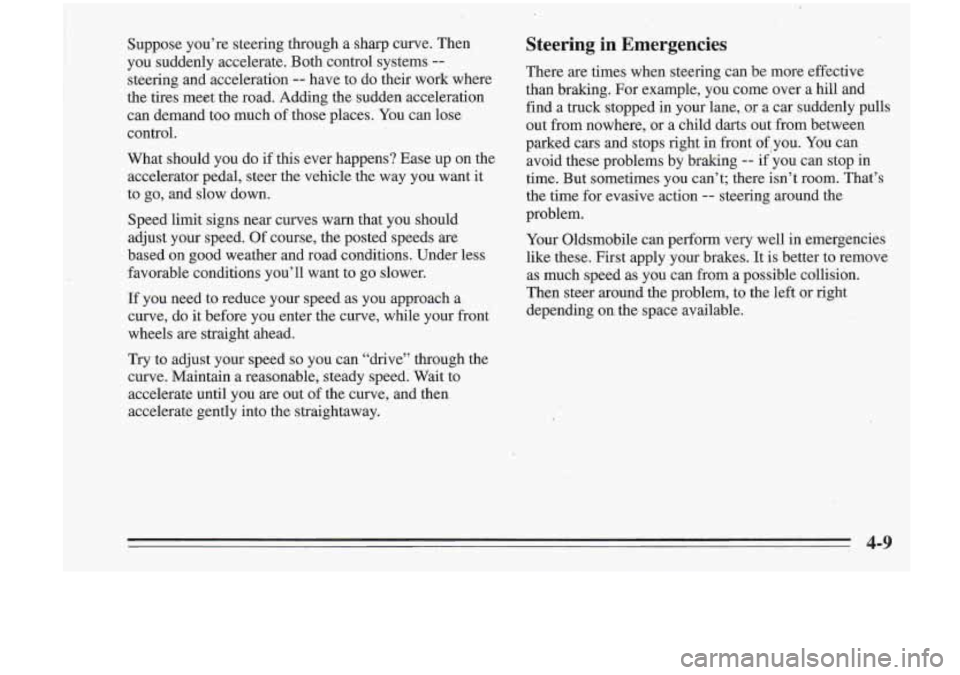
Suppose you’re steering through a sharp curve. Then
you suddenly accelerate. Both control systems
--
steering and acceleration -- have to do their work where
the tires meet the road. Adding the sudden acceleration
can demand too much of those places. You can lose
control.
What should you do if’this ever happens? Ease up on the
accelerator pedal, steer the vehicle the way you want it
to go, and slow down.
Steering in Emergencies
There are times when steering can be more effective
than braking. For example, you come over a hill and
find a truck stopped in your lane, or a car suddenly pulls
out from nowhere, or a child darts out
from between
parked cars and stops right in front of,you. You can
avoid these problems by braking
-- if’you can stop in
time. But sometimes you can’t; there isn’t room. That’s
the time for evasive action
-- steering around the
Speed limit signs near curves warn that you should problem.
adjust your speed. Of course, the posted speeds are
Your Oldsmobile can perform very well in emergencies
based on good weather and road conditions. Under less like these. First apply your brakes. It is better to remove
favorable conditions you’ll want to go slower.
as much speed as you can from a possible collision.
If you need to reduce your speed as’you approach a Then steer around the problem, to the left or right’
curve, do it before you enter the curve, while your front depending
on the, space available.
wheels are straight ahead.
Try to .adjust your speed so you can “drive” through the
cye. Maintain a reasonabie, steady speed. Wait
to
accelerate until you are out of the curve, and then
accelerate gently into the straightaway.
4-9
Page 148 of 340
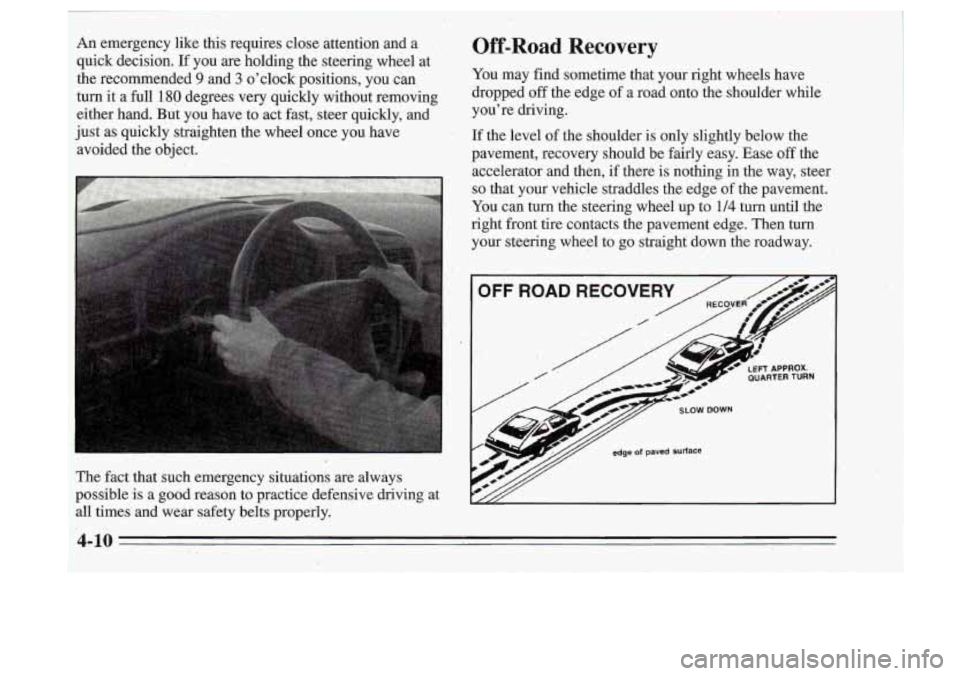
An emergency like this requires close attention and a '
quick decision. If you are holding the steering wheel at
the recommended
9 and 3 o'clock positions, you .can
turn it a
full 180 degrees very quickly without removing
either hand. But you have to act fast, steer quickly, and
just
as quickly straighten the wheel once you have
avoided the object.
..
I'
,.
The fact. that such emergency situations are always
possible is a good reason
to practice defensive driving at
all times
and wear safety belts properly.
4-10
Page 149 of 340
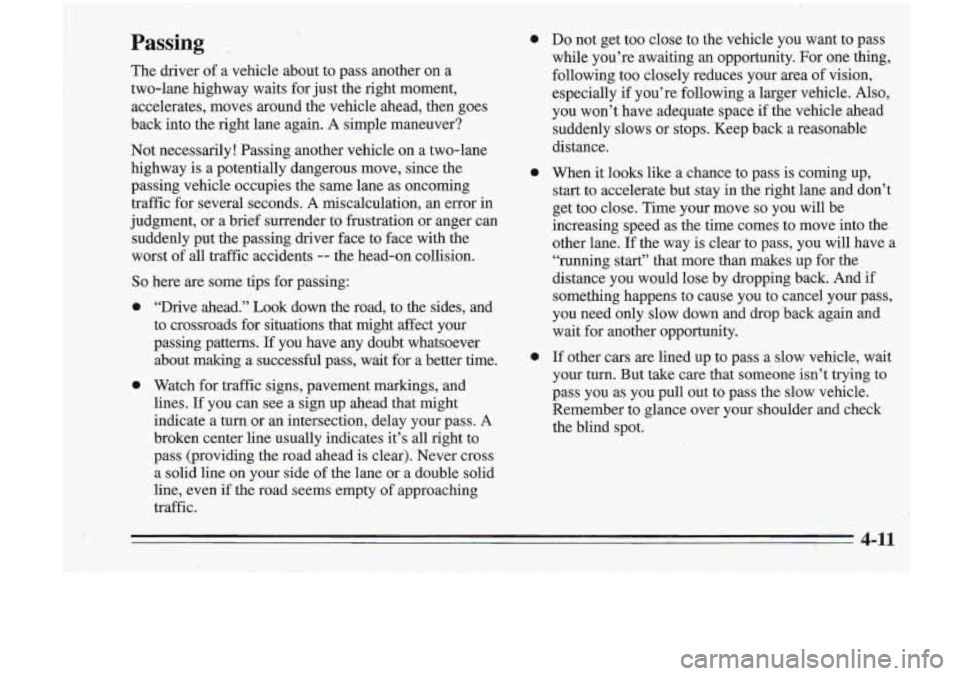
Passing
The driver of a vehicle about to pass another on a
two-lane highway waits for just the right moment,
accelerates, moves around the vehicle ahead, then goes
back into the right lane again. A simple maneuver?
Not necessarily! Passing another vehicle on a two-lane
highway is a potentially dangerous move, since the
passing vehicle occupies the same lane as oncoming
traffic for several seconds. A miscalculation, an error in
judgment, or a brief surrender to frustration or anger can
suddenly put the passing driver face to face with the
worst of all traffic accidents
-- the head-on collision.
So here are some tips for passing:
0 “Drive ahead.” Look down the road, to the sides, and
to crossroads for situations that might affect your
passing patterns.
If you have any doubt whatsoever
about making
a successful pass, wait for a better time.
0 Watch for traffic signs, pavement markings, .and
lines. If you can see a sign up ahead that might
~ indicate a turn or an intersection, delay your pass. A
broken center line usually indicates it’s
all right to
pass (providing the road ahead is clear).’Never cross
a solid line on your side
of the lane or a double solid
line, even
if the road st ns empty of approaching
traffic..
Do not .get too close to the vehicle you want to pass
while you’re awaiting an opportunity. For one thing,
following too closely reduces your area
of vision,
especially if you’re following a larger vehicle. Also,
you won’t have adequate space
if the vehicle ahead
suddenly slows or stops. Keep back a reasqnable
distance.
0
0
When it looks like a chance to pass is ,coming up,
start to accelerate but stay in the right lane and don’t
get too close. Time your move
so you will be
increasing speed- as the time comes to move into the
other lane. If the way is clear‘to pass, you will have a
“running start” that more than makes up for the
distance you would lose by dropping back
... And if
something happehs to cause you to cancel your pass,
you need only slow down and drop back again and
wait for another opportunity.
’
If other cars are lined up to pass a slow vehicle, wait
your turn. But take care that someone isn’t trying
to
pass you as you pull out to pass the slow vehicle.
Remember- to glance over your shoulder and check.
the blind spot.
, 4-11
Page 150 of 340
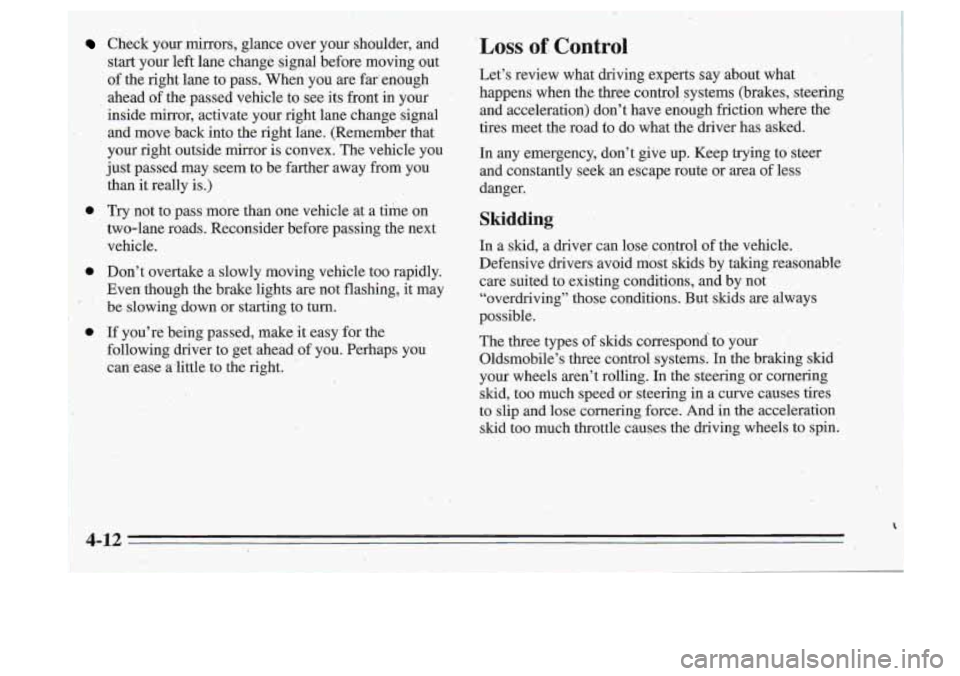
0
0
.. ..
Check your mirrors, glance over your shoklder, and
start your left lane change signal before moving out
of the right lane to pass. When you are far’enough
ahead of the passed vehicle to see its front in your
inside mirror, activate your right$ lane ,change signal
and move back into the right lane. (Remember that
your right outside mirror
is convex. The vehicle you
just passed may seem to be,farther away from
you
than it really is.)
Try not to pass more than one vehicle at a tihe on
two-lane roads. Reconsider before passing the next
vehicle.
Don’t overtake a slowly moving vehicle too rapidly.
Even though the brake lights are not flashing, it.may
be slowing down or starting tu turn.
If you’re being passed, make it easy for the
following driver to get ahead of you. Perhaps you
cmease a,little to the right.
.. : ‘ . .. ~
Loss of Control
Let’s review what driving experts say about what ’
happens when the three control systems (brakes, steering
and acceleration) don’t have enough friction where the
tires meet .the road
to do what ‘the driver has asked.
In any emergency, don’t give up. Keep trying to steer and constantly seek an es-c-gpe route or area
.~f less
danger.
Skidding
In a skid, a driver can lose control of the vehicle.
Defensive drivers avoid most skids by taking reasonable
care suited to existing conditions, and by not
“overdriving” those conditions. But skids are always
possibk.
The three types of skids correspondjo your
Oldsmobile’s three control systems. In the braking skid
your wheels aren’t rolling.
In the steering or cornering
skid, too much speed or steering in
a curve causes tires
to slip and lose cornering force. And in the acceleration
skid too much throttle causes the driving wheels to,spin.
, .*
I
4-12